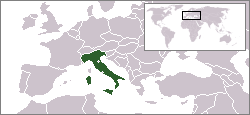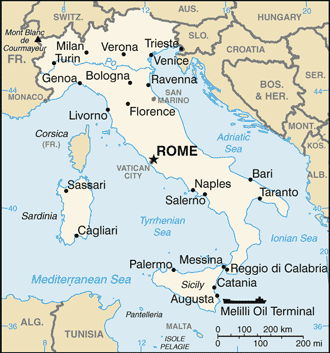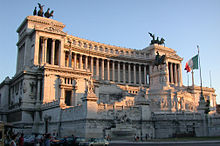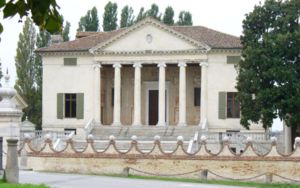General
Italy (Italian: Repubblica Italiana or Italia) is a country in southern Europe. It comprises a boot-shaped peninsula and two large islands in the Mediterranean Sea, Sicily and Sardinia, and shares its northern alpine boundary with France, Switzerland, Austria and Slovenia. The independent countries of San Marino and the Vatican City are enclaves within Italian territory.
| ||||

| ||||
| Official language | Italian1 | |||
| Capital and largest city | Rome | |||
| President | Carlo Azeglio Ciampi | |||
| Prime minister | Silvio Berlusconi | |||
| Area - Total - % water |
Ranked 71st 301,336 km² 2.40% | |||
| Population - Total (July 2005) - Density |
Ranked 23rd 58,462,375 194/km² | |||
| Unification | 17 March 1861 | |||
| GDP (2003) - Total (PPP) - Total (nom.) - GDP/capita (PPP) - GDP/capita (nom.) |
$1.559 trillion (8th) $1.466 trillion (6th) $27,050 (19th) $29,014 (20th) | |||
| Currency | Euro (€)2 | |||
| Time zone - in summer |
CET (UTC+1) CEST (UTC+2) | |||
| National anthem | Il Canto degli Italiani | |||
| Internet TLD | .it | |||
| Calling Code | +39 | |||
| 1 French is co-official in the Aosta Valley; German is co-official in South Tyrol. 2 Prior to 1999: Italian Lira. | ||||
History
Main article: History of Italy
Italy has shaped the cultural and social development of the whole Mediterranean area, deeply influencing European culture as well. Important cultures and civilizations have existed there since prehistoric times. After Magna Graecia, the Etruscan civilization and especially the Roman Republic and Empire that dominated this part of the world for many centuries, Italy was central to European philosophy, science and art during the Middle Ages and the Renaissance.
Modern Italy became a nation-state belatedly — on March 17, 1861, when most of the states of the peninsula were united under king Victor Emmanuel II of the Savoy dynasty, which ruled over Sardinia and Piedmont. The architects of Italian unification were Count Camillo Benso di Cavour, the Chief Minister of Victor Emmanuel, and Giuseppe Garibaldi, a general and national hero. Rome itself remained for a decade under the Papacy, and became part of the Kingdom of Italy only on September 20, 1870. The Vatican is now an independent enclave surrounded by Rome.
Politics
Main article: Politics of Italy
The 1948 constitution established a bicameral parliament (Parlamento), consisting of a Chamber of Deputies (Camera dei Deputati) and a Senate (Senato della Repubblica), a separate judiciary, and an executive branch composed of a Council of Ministers (cabinet) (Consiglio dei ministri), headed by the prime minister (Presidente del consiglio dei ministri). The President of the Republic (Presidente della Repubblica) is elected for 7 years by the parliament sitting jointly with a small number of regional delegates. The president nominates the prime minister, who proposes the other ministers (formally named by the president). The Council of Ministers must retain the support (Fiducia) of both houses.
The houses of parliament are popularly and directly elected by a mixed majoritarian and proportional representation system. Under 1993 legislation, Italy has single-member districts for 75% of the seats in parliament; the remaining 25% of seats are allotted on a proportional basis. The Chamber of Deputies has officially 630 members (de facto, 619 only after the 2001 elections). In addition to 315 senators, elected members, the Senate includes former presidents and several other persons (no more than 5) appointed for life by the President of the Republic according to special constitutional provisions. Both houses are elected for a maximum of 5 years, but either may be dissolved before the expiration of its normal term. Legislative bills may originate in either house and must be passed by a majority in both.
The Italian judicial system is based on Roman law modified by the Napoleonic code and later statutes. A constitutional court, the Corte Costituzionale, passes on the constitutionality of laws, and is a post-World War II innovation.
Regions
Main article: Regions of Italy
Italy is subdivided into 20 regions (regioni, singular regione), of which five enjoy a special autonomous status that enables them to enact legislation on some of their specific local matters, marked by an *:
- Abruzzo
- Basilicata
- Calabria
- Campania
- Emilia-Romagna
- Friuli-Venezia Giulia *
- Latium (Lazio)
- Liguria
- Lombardy (Lombardia)
- Marche
- Molise
- Piedmont (Piemonte)
- Apulia (Puglia)
- Sardinia (Sardegna) *
- Sicily (Sicilia) *
- Tuscany (Toscana)
- Trentino-South Tyrol (Trentino-Alto Adige) *
- Umbria
- Aosta Valley (Valle d'Aosta)*
- Veneto
All regions except Valle d'Aosta are further subdivided into two or more provinces.
Geography
Main article: Geography of Italy
Italy consists predominantly of a large peninsula with a distinctive boot shape that extends into the Mediterranean Sea, where together with its two main islands Sicily and Sardinia it creates distinct bodies of water, such as the Adriatic Sea to the north-east, the Ionian Sea to the south-east, the Tyrrhenian Sea to the south-west and finally the Ligurian Sea to the north-west.
The Apennine mountains form the backbone of this peninsula, leading north-west to where they join the Alps, the mountain range that then forms an arc enclosing Italy from the north. Here is also found a large alluvial plain, the Po-Venetian plain, drained by the Po River and its many tributaries flowing down from the Alps, Apennines and Dolomites. Other well-known rivers include the Tiber, Adige and Arno.
Its highest point is Mont Blanc (Monte Bianco) at 4,810 m, but Italy is more typically associated with two famous volcanoes: the currently dormant Vesuvius near Naples and the very active Etna on Sicily.
Demographics
Main article: Demographics of Italy
Italy is largely homogeneous in language and religion but is diverse culturally, economically, and politically. The country has the fifth-highest population density in Europe at 194 persons per square kilometre. Indigenous minority groups are small. For a country of 58,5 million people, Italy has a smaller number of migrants compared to Spain, France, and Germany. According to ISTAT, the national statistical office, Italy has 2 million (3.5%) foreigners, including legal immigrants and their children. The largest immigrant groups are Romanian (445,812) (unnoficially 1,000,000 ), Albanian (270,383), Moroccan (253,362) and Chinese (86,738). There are many other ethnic groups, like Filipinos, Tunisians, Serbians, and Ukrainians, but they make very small numbers.
Economy
Main article: Economy of Italy
Italy has a diversified industrial economy with roughly the same total and per capita output as France and the United Kingdom. This capitalistic economy remains divided into a developed industrial north, dominated by private companies, and a less developed agricultural south, with 20% unemployment. In comparison to its western European neighbours, it has a high number of small to medium sized enterprises (SMEes).
Most raw materials needed by industry and more than 75% of energy requirements are imported. Over the past decade, Italy has pursued a tight fiscal policy in order to meet the requirements of the Economic and Monetary Union and has benefited from lower interest and inflation rates. Italy joined the Euro from its conception in 1999.
Italy's economic performance has at times lagged behind that of its EU partners, and the current government has enacted numerous short-term reforms aimed at improving competitiveness and long-term growth. It has moved slowly, however, on implementing certain structural reforms favoured by economists, such as lightening the high tax burden and overhauling Italy's rigid labour market and expensive pension system, because of the current economic slowdown and opposition from labour unions.
Although Roman Catholicism is the majority religion (85% of native-born citizens are nominally Catholic) there are mature Protestant and Jewish communities and a growing Muslim (see: Islam in Italy) immigrant community, as many come from Albania, Morocco, and Tunisia.
Culture
Main article: Culture of Italy
Italy is well-known for its art and culture as well as popular iconic monuments, among them the leaning tower of Pisa and the Roman Colosseum, as well as for its food (pizza, pasta, etc.), wine, lifestyle, elegance, design, cinema, theatre, literature, poetry, visual arts, music (notably Opera), holidays, and generally speaking, for taste.
Europe's Renaissance period began in Italy during the 14th and 15th centuries. Literary achievements, such as the poetry of Dante, Petrarch, Tasso, and Ariosto and the prose of Boccaccio, Machiavelli, and Castiglione exerted a tremendous and lasting influence on the subsequent development of Western culture, as did the painting, sculpture, and architecture contributed by giants such as Filippo Brunelleschi, Leonardo da Vinci, Raffaello, Botticelli, Fra Angelico, and Michelangelo. Modern artists include the sculptor Tommaso Geraci.
The musical influence of Italian composers Palestrina, Monteverdi, Corelli and Vivaldi proved epochal; in the 19th century, Italian romantic opera flourished under composers Gioacchino Rossini, Giuseppe Verdi, and Giacomo Puccini. Contemporary Italian artists, writers, filmmakers, architects, composers, and designers continue to contribute significantly to Western culture.
Football is the main national sport and the Italians are well known for their passion for this sport. Italy has won the Football World Cup three times: in 1934, 1938 and 1982.
Languages
Main article: Languages of Italy
The official language of Italy is Italian - a direct descendant of Latin (some 75% of Italian words are of Latin origin), which is itself believed to be a descendant of Kurgan - a language spoken in the area north of the Black and Caspian Seas some five thousand years ago which spawned all of the major Indo-European language families (including the Romance, Slavic and Germanic languages - but not Finnish, Magyar and Basque for example).
Prior to unification in 1861, Italian spoken throughout the country was incredibly varied - with dialects being virtually mutually incomprehensible in most of the country. Indeed, each historical region of Italy had its own dialect, with variants existing at the township-level. Massimo d'Azeglio, one of Cavour's ministers, is said to have stated, following Italian unification, that having created Italy, all that remained was to create Italians. Given the variation in Italian language throughout the peninsula, it was quickly establised that 'proper' or 'standard' Italian would be based on the Florentine dialect spoken in most of Tuscany (given that it was the first region to produce authors such as Dante Alighieri, who in 1291 wrote the Divina Commedia). A national education system was established - leading to a decrease in variation in the Italian spoken throughout the country over time. However, it was not until the advent of the state television broadcaster, RAI that Italian truly became standardised.
Today, Italian is fully comprehensible to all throughout the country, but regional variations in the form of accents and vowel emphasis persist. In addition, particular dialects have become cherised beacons of regional variation and are becoming recently more and more protected by the newly-created Regional Assemblies (especially the Neapolitan dialect which is extensively used for the singing of popular folk-songs).
Apart from standard Italian and regional variations, a number of truly separate languages do exist. In the north, the province of Bolzano (or Bozen in German) is almost entirely German-speaking; the area was awarded to Italy following the First World War and her defeat of the Austro-Hungarian Empire. Pockets of German speakers also persist in other north-western Italian regions - a remnant of the old Austrian influence on this area of Italy. In total some 300,000 or so Italians speak German as their first language and indeed identify themselves as ethnic Austrians. Some 120,000 or so people live in the Valle D'Aosta region, where a Franco-Provençal dialect very similar to French called Patois is spoken. About 80,000 Slovene-speakers live in the north-eastern region of Friuli-Venezia Giulia near the border with Slovenia. Some 40,000 Ladin-speakers (Ladin is a descendant of Latin and possibly the closest living relative to the ancient tongue) also live in the Trentino-Alto Adige region and in the Veneto region. A very large community of some 700,000 people in Friuli speak Friulian - a romance language too distinct from Italian to be considered the same language. In the Molise region of central-south Italy some 4,000 people speak Serbo-Croatian - these are the descendants of a group of people who migrated from the Balkans in the Middle Ages. Scattered across Southern Italy are a number of some 30,000 Greek-speakers - considered to be the last surviving traces of the region's Greek heritage (Ancient Greek colonists reached Southern Italy and Sicily about 2500 BC). Some 15,000 Catalan speakers reside around the area of Alghero in the north-west corner of Sardinia - believed to be the result of a migration of a large group of Catalans from Barcellona in ages past. Around 100,000 or so people in Southern Italy and in central Sicily speak Albanian - the result of past migrations. Finally, the largest group of non-Italian speakers (some 1.6 million people) are the ones who speak Sardinian - a romance language which evolved quite independently from Italian. The arrival of immigrants has generated a plethora of new languages, including Arab, Hindi, Punjabi, Urdu, Turkish, Kurdish, Mandarin and others. It must be stressed that even today, variations in local accents allow people from one town to distinguish people from a neighbouring town which may be only a few miles away.
External links
Template:Wikinewscat Template:Wikitravel
Official sites
- Presidenza della Repubblica - Official site of the Italian president (in Italian)
- Parlamento - Official site of the Italian parliament (Senate in Italian only)
- Italia.gov.it Main governmental portal (in Italian)
- Ministero degli Affari Esteri, Italian Foreign Office
- Istituto nazionale di statistica
General sites
- Map of Italy - Maps of Italy and its regions
- Italy - maps and weather - Maps and 6‑day weather forecasts
- Italiansrus.com - Guide to Italy and Italian Culture







